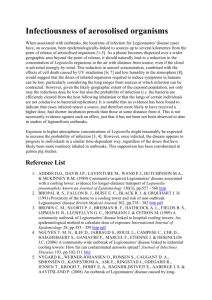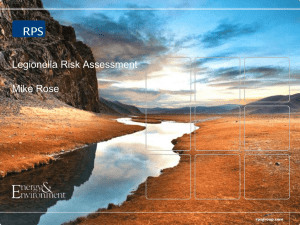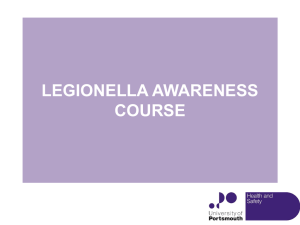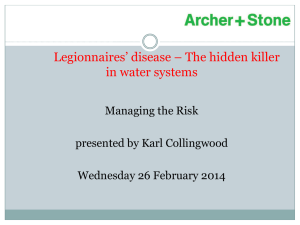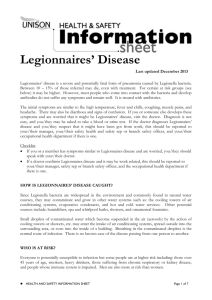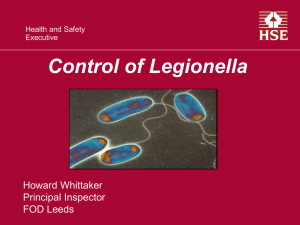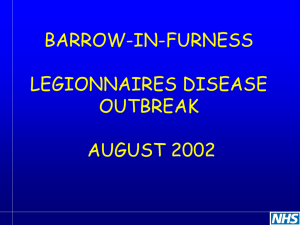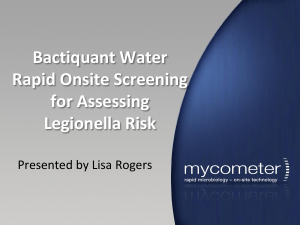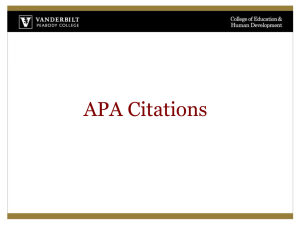Legionnaires Disease
advertisement
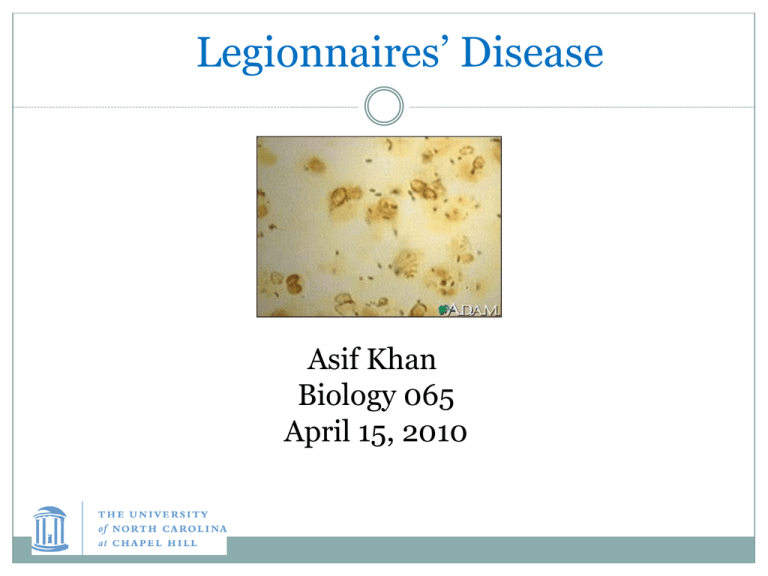
Legionnaires’ Disease Asif Khan Biology 065 April 15, 2010 Background July 21st, 1976: First Discovered at the American Legion Convention. August 2nd, 1976: Tort Claim Act (50 million doses) Mist of Confusion Early 1977: Dr. Joseph McDade Legionella pneumophilia: the Legions; “lungloving” as it infects alveolar macrophages. BBC (editor). (2003). Legionnaires’ Disease-a History of its Disocvery. BBC. Retrieved from: …..http://www.bbc.co.uk/dna/h2g2/A882371 Image Courtesy: http://www.phoenixmasonry.org/masonicmuseum/fraternalism/images/American_legion_color_emblem.jpg Environment Dr. Carl Fliermans: lipids of L.pneumophilia resembled those of thermophilic bacteria. Grows best in warm water sources such as: hot tubs, cooling towers, hot water tanks, large plumbing systems, or parts of the air-conditioning systems of large buildings. BBC (editor). (2003). Legionnaires’ Disease-a History of its Disocvery. BBC. Retrieved from: …..http://www.bbc.co.uk/dna/h2g2/A882371 Image Courtesy: http://www.britishcouncil.org/science-dv-climate-330x270-cooling-towers.jpg Environment Hilbi, H et al. (2010). Update on Legionnaires’ disease: pathogenesis, epidemiology, detection and control. Molecular Microbiology. Micromeeting 71 [1] p 2. Infectious Agent A thin and flagellated gram-negative bacterium. Non-capsulated rod-like bacteria. Dot/Icm secretion system to inject large numbers of protein effectors into the host cells. Pseudopod acts as a phagocytosis. Incubation period: two to ten days. Madigan M and Martinko J (editors). (2005). Brock Biology of Microorganisms (11th ed.). …..Prentice Hall. Image courtesy: http://www.aquatreat.co.uk/aquatreat/LEGIONNAIRES%27%20DISEASE.jpg Risk Factors Opportunistic Disease: underlying illness/weak immune system. Nosocomial infections are major concerns. Middle-aged, elderly, COPD, smokers and other genetic susceptible patients are primary targets. OSHA (editor). (2007). LEGIONNAIRES' DISEASE: QUESTIONS AND ANSWERS. U.S. Department of Labor …...Occupational Safety &.Health Administration. Retrieved from: …..http://www.osha.gov/dts/osta/otm/otm_iii/otm_iii_7.html#1 Image Courtesy: http://www.childrenshospital.org/chnews/10-12-05/images/handHygieneFact298.gif Symptoms Early Symptoms Malaise, muscle aches, lethargy and slight headaches. High Fever, non-productive cough, abdominal pain, diarrhea. Late Symptoms Extreme lethargy, comatose state Impaired kidney and liver functioning Nervous System disorders Bartram, J et al. (2007). Legionella and the prevention of legionellosis. World Health …..Organization. WHO Press: India. p. 1-27 Imperiale T.F., Gupta S.K. and Sarosi G.A. (2001). Evaluation of the Winthrop-University …..Hospital criteria to identify Legionella pneumonia. Chest, 120(4):1064–1071. OSHA (editor). (2009). Legionnaires’ Disease. U.S. Department of Labor Occupational Safety & …..Health Administration. Retrieved from: …..http://www.osha.gov/dts/osta/otm/legionnaires/faq.html Diagnosis Urinary Antigen Test The serogroup of Legionella often times overlap with other immunocompromised diseases. Culture Lung biopsy, respiratory secretions, sputum Less preferable technique CDC (Editor). 2008. Patient Facts: Learn More about Legionnaires' disease. Centers for Disease …..Control and Prevention. Retried from: http://www.cdc.gov/legionella/patient_facts.htm Rathore, M. H. (2009). Legionella Infection: Treatment & Medication …..Emedicine from WebMD. Retrieved from: http://emedicine.medscape.com/article/965492 Photo Courtesy: http://www.alere.co.uk/images/product/thumbs/1_prod_4f15ebc716c482f10018f230ab1bb8cd.gif Transmission L. pneumophilia is NOT spread by human-human interaction. Mist or vapor contaminated with the bacteria. Warm stagnant water (90-122 F) in complex systems is ideal. OSHA (editor). (2007). LEGIONNAIRES' DISEASE: QUESTIONS AND ANSWERS. U.S. Department …..of Labor Occupational Safety &.Health Administration. Retrieved from: …..http://www.osha.gov/dts/osta/otm/otm_iii/otm_iii_7.html#1 Incidence 8,000 to 18,000 people are hospitalized in US with more than 4,000 deaths. 32,000 cases between1995 and 2005. Potential major outbreaks with the retiring baby boomers? EWGLI (editor). (2009). About Legionnaires' Disease (Legionellosis). The European Working …..Group for Legionella Infections. Retrieved from: …..http://www.ewgli.org/data/factsheets/about_ld.htm#Outbreaks Treatment Wide-range antibiotics to treat pneumonia Fluoroquinolones (levofloxacin, moxifloxacin) Macrolides (azithromycin) Mechanism Quinolones: DNA gyrase inhibitors Macrolides: binds to 50S subunit of ribosomes CDC (Editor). 2008. Patient Facts: Learn More about Legionnaires' disease. Centers for Disease …..Control and Prevention. Retried from: http://www.cdc.gov/legionella/patient_facts.htm Rathore, M. H. (2009). Legionella Infection: Treatment & Medication …..Emedicine from WebMD. Retrieved from: http://emedicine.medscape.com/article/965492 Photo Courtesy: http://imghost1.indiamart.com/data2/KF/CB/MY-1678174/2macrolides-drugs-250x250.jpg Prevention Regularly maintain and clean cooling towers and evaporative condensers to prevent growth of Legionnaires’ disease Bacteria (LDB). This should include twice-yearly cleaning and periodic use of chlorine or other effective biocide. Maintain domestic water heaters at 60°C (140°F). The temperature of the water should be 50°C (122°F) or higher at the faucet. Avoid conditions that allow water to stagnate. Large water-storage tanks exposed to sunlight can produce warm conditions favorable to high levels of LDB. Frequent flushing of unused water lines will help alleviate stagnation. OSHA (editor). (2009). Legionnaires’ Disease. U.S. Department of Labor Occupational Safety & …..Health Administration. Retrieved from: http://www.osha.gov/dts/osta/otm/legionnaires/faq.html Future No evidence of drug-resistance Survival techniques both inside and outside of the human environment is remarkable. Hence, Legionella pneumophilia is here to stay. Treatment can effectively treat yet prevention is always better. References Barbaree, J. M., Breiman R. F., Dufour A. P. (1993). Legionella: Current Status and Emerging …..Perspectives - American Society for Microbiology, Washington DC Bartram, J et al. (2007). Legionella and the prevention of legionellosis. World Health …..Organization. WHO Press: India. p. 1-27 BBC (editor). (2003). Legionnaires’ Disease-a History of its Disocvery. BBC. Retrieved from: …..http://www.bbc.co.uk/dna/h2g2/A882371 CDC (Editor). 2008. Patient Facts: Learn More about Legionnaires' disease. Centers for Disease …..Control and Prevention. Retried from: http://www.cdc.gov/legionella/patient_facts.htm EWGLI (editor). (2009). About Legionnaires' Disease (Legionellosis). The European Working …..Group for Legionella Infections. Retrieved from: …..http://www.ewgli.org/data/factsheets/about_ld.htm#Outbreaks Fitzgeorge RB et al. (1983). Aerosol infection of animals with strains of Legionella pneumophila …..of different virulence: comparison with intraperitoneal and intranasal routes of infection. …..Journal of Hygiene, London, 90(1):81–89. Imperiale T.F., Gupta S.K. and Sarosi G.A. (2001). Evaluation of the Winthrop-University …..Hospital criteria to identify Legionella pneumonia. Chest, 120(4):1064–1071. Madigan M and Martinko J (editors). (2005). Brock Biology of Microorganisms (11th ed.). …..Prentice Hall. OSHA (editor). (2009). Legionnaires’ Disease. U.S. Department of Labor Occupational Safety & …..Health Administration. Retrieved from: …..http://www.osha.gov/dts/osta/otm/legionnaires/faq.html OSHA (editor). (2007). LEGIONNAIRES' DISEASE: QUESTIONS AND ANSWERS. U.S. …..Department of Labor Occupational Safety &.Health Administration. Retrieved from: …..http://www.osha.gov/dts/osta/otm/otm_iii/otm_iii_7.html#1 Rathore, M. H. (2009). Legionella Infection: Treatment & Medication …..Emedicine from WebMD. Retrieved from: http://emedicine.medscape.com/article/965492 Swanson M and Heuner K (2008). Legionella: Molecular Microbiology. Caister Academic Press. Special Thanks to Christopher Hurt, MD. Clinical Instructor UNC School of Medicine. Specialized in Internal Medicine. RESEARCH SUMMARY: Acute HIV infection, transmission of antiretroviral drug resistance, substance use/abuse and HIV risk, and behavioral approaches to secondary HIV prevention. Detailed information can be obtained here: http://www.med.unc.edu/infdis/faculty/christopher-hurt-md Joseph P. Vogel. Department of Molecular Microbiology. Washington University School of Medicine Ph.D., Molecular Biology Princeton University, NJ. Research Intersest: “The key to Legionella virulence is its ability to survive and replicate within alveolar macrophages. In order to accomplish this, Legionella uses a specialized secretion system called "Dot/Icm" to inject a large number of protein effectors into it's host cell.” Detailed information can be obtained here: http://microbiology.wustl.edu/Bio_Sketches/vogelCV.html
